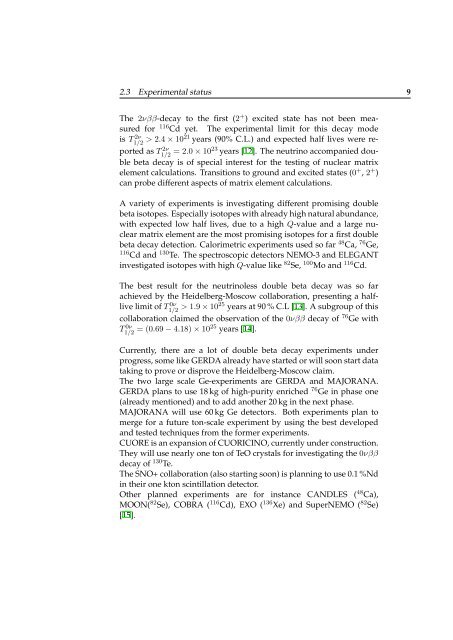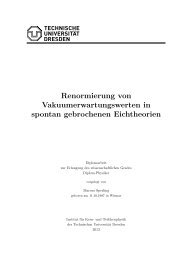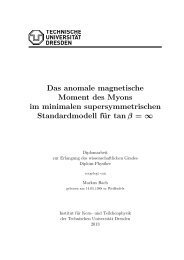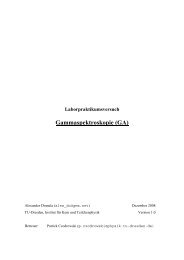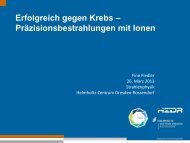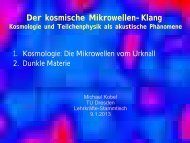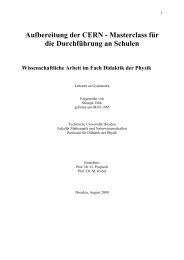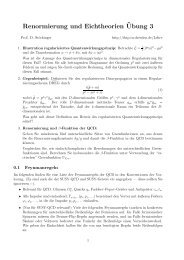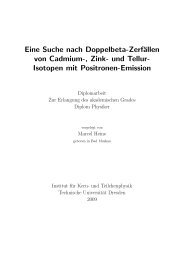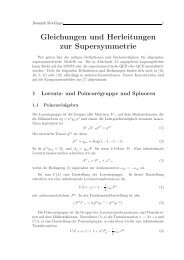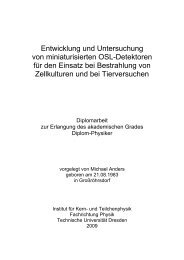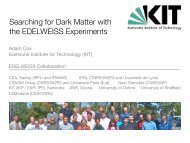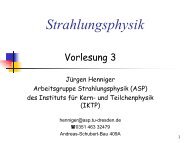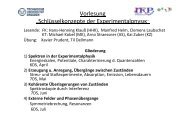a design study for a cobra upgrade to - Institut für Kern- und ...
a design study for a cobra upgrade to - Institut für Kern- und ...
a design study for a cobra upgrade to - Institut für Kern- und ...
Create successful ePaper yourself
Turn your PDF publications into a flip-book with our unique Google optimized e-Paper software.
2.3 Experimental status 9<br />
The 2νββ-decay <strong>to</strong> the first (2 + ) excited state has not been measured<br />
<strong>for</strong> 116Cd yet. The experimental limit <strong>for</strong> this decay mode<br />
is T 2ν<br />
1/2 > 2.4 × 1021 years (90% C.L.) and expected half lives were reported<br />
as T 2ν<br />
1/2 = 2.0 × 1023 years [12]. The neutrino accompanied double<br />
beta decay is of special interest <strong>for</strong> the testing of nuclear matrix<br />
element calculations. Transitions <strong>to</strong> gro<strong>und</strong> and excited states (0 + , 2 + )<br />
can probe different aspects of matrix element calculations.<br />
A variety of experiments is investigating different promising double<br />
beta iso<strong>to</strong>pes. Especially iso<strong>to</strong>pes with already high natural ab<strong>und</strong>ance,<br />
with expected low half lives, due <strong>to</strong> a high Q-value and a large nuclear<br />
matrix element are the most promising iso<strong>to</strong>pes <strong>for</strong> a first double<br />
beta decay detection. Calorimetric experiments used so far 48 Ca, 76 Ge,<br />
116 Cd and 130 Te. The spectroscopic detec<strong>to</strong>rs NEMO-3 and ELEGANT<br />
investigated iso<strong>to</strong>pes with high Q-value like 82 Se, 100 Mo and 116 Cd.<br />
The best result <strong>for</strong> the neutrinoless double beta decay was so far<br />
achieved by the Heidelberg-Moscow collaboration, presenting a halflive<br />
limit of T 0ν<br />
1/2 > 1.9 × 1025 years at 90 % C.L [13]. A subgroup of this<br />
collaboration claimed the observation of the 0νββ decay of 76 Ge with<br />
T 0ν<br />
1/2 = (0.69 − 4.18) × 1025 years [14].<br />
Currently, there are a lot of double beta decay experiments <strong>und</strong>er<br />
progress, some like GERDA already have started or will soon start data<br />
taking <strong>to</strong> prove or disprove the Heidelberg-Moscow claim.<br />
The two large scale Ge-experiments are GERDA and MAJORANA.<br />
GERDA plans <strong>to</strong> use 18 kg of high-purity enriched 76 Ge in phase one<br />
(already mentioned) and <strong>to</strong> add another 20 kg in the next phase.<br />
MAJORANA will use 60 kg Ge detec<strong>to</strong>rs. Both experiments plan <strong>to</strong><br />
merge <strong>for</strong> a future <strong>to</strong>n-scale experiment by using the best developed<br />
and tested techniques from the <strong>for</strong>mer experiments.<br />
CUORE is an expansion of CUORICINO, currently <strong>und</strong>er construction.<br />
They will use nearly one <strong>to</strong>n of TeO crystals <strong>for</strong> investigating the 0νββ<br />
decay of 130 Te.<br />
The SNO+ collaboration (also starting soon) is planning <strong>to</strong> use 0.1 %Nd<br />
in their one k<strong>to</strong>n scintillation detec<strong>to</strong>r.<br />
Other planned experiments are <strong>for</strong> instance CANDLES ( 48 Ca),<br />
MOON( 82 Se), COBRA ( 116 Cd), EXO ( 136 Xe) and SuperNEMO ( 82 Se)<br />
[15].


